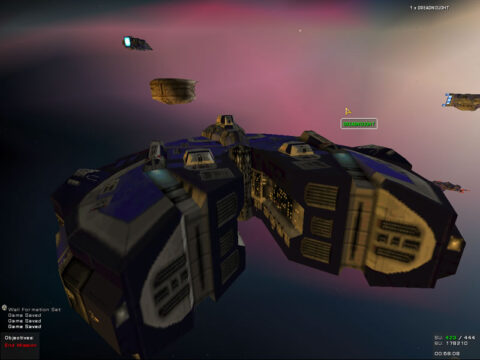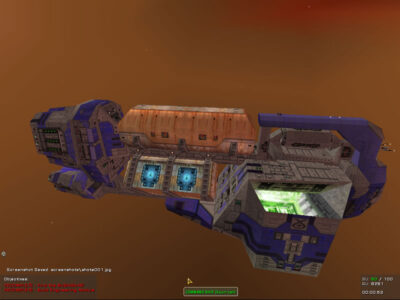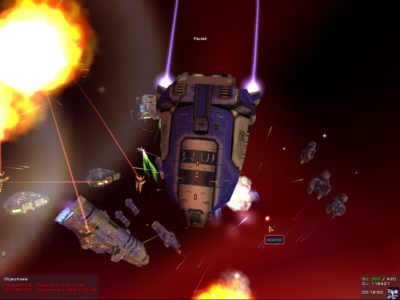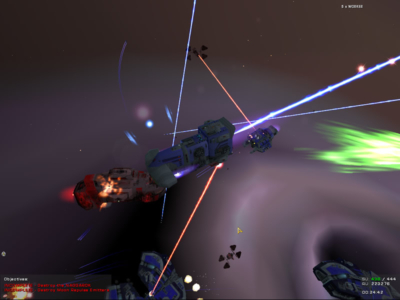
Homeworld: Cataclysm (Emergence)
Written by: Stoo
Date posted: May 3, 2005
- Genre: Strategy
- Developed by: Barking Dog Studios
- Published by: Sierra
- Year released: 2000
- Our score: 10
Back in 1999, the release of Relic’s Homeworld was a pretty significant event for real-time strategy. HW wasn’t just a game, you see; it was a thing of beauty. Set in the depths of space it gave you an armada of fighters, destroyers and carriers to control, all in glorious, spinny-rotating-o-vision 3D. It also featured a fluid, intuitive control system, and stripped back the usual base-building mechanics of RTS gameplay, so as to concentrate on the tactics and combat. To cap it all off, there was poignant and moving story about a race of Exiles making their way home across as a hostile galaxy.
Unsurprisingly HW was a big hit, so you’d probably expect a sequel to have emerged sooner or later. Well, one did, in 2003. However, that’s not what I’m here to talk to you about. Cataclysm – produced under license by Barking Dog studios – was you see never put forward as a sequel. Instead, it was billed as a “standalone episode”. It’s powered by exactly the same engine, uses a very similar interface, and the mechanics of play are pretty much the same. What is new is the selection of ships and the story. It’s the kind of material you might expect to see in an “expansion pack” for a game, but unlike an expansion does not require you to own a copy of the original.
Given the similarities of Cataclysm to its illustrious predecessor, I’m not going to ramble on at length about what makes HW gameplay great. Suffice to say that a typical battle is pretty amazing to both see and command: a swarm of bombers drive and strafe across an enemy carrier, whilst lumbering destroyers close in with heavy cannon firing and interceptors distract the escorts, is pretty awesome. The ships have a full range of motion in three dimensions, and yet the controls are remarkably easy to get to grips with. It’s frantic and chaotic at times, but never cumbersome or confusing. In short, there’s the spectacular Babylon-5 style show of starships hammering at each other, but also great tactical play. If and when I ever review HW2 I might reassess this from scratch, but for now just take my word for it: the core HW gameplay was great, still is, and few RTS games have come close to matching it.
So with that established, this relatively brief review can establish what’s changed from HW and whether that’s for the better or not. First up, the story: in HW the Higaaran exiles reclaimed their homeworld from the Taidann empire, after a long and bitter struggle. In the years immediately following they have reverted back to their old clan-based culture and are busy establishing themselves on Higaara and rebuilding their society. Some of these clans are large and wealthy, with large fleets of warships entrusted with keeping the peace around the homeworld. The miners of Clan Somtaaw, however, are relatively lowly and unimportant, lacking both resources and influence. Having scraped together the resources to build a couple of mining vessels, Somtaaw now set out looking for their fortune amongst big floating rocks in deep space. Not the most glamorous existence, but they are keen to rise to better things.

Your mining vessel at the start of the game. Over time it becomes more of an ad-hoc military command ship.
However space is still a dangerous place, with remnants of the Taidann fleet prowling around and forging alliances with pirate raiders. It turns out there are even nastier threats out there, though, when early in the game Somtaww accidentally release a creature known as the Beast. Some kind of horrific techno-organic entity, it’s capable of rapidly infecting and siezing control of ships and their crews. Once unleashed, the Beast quickly gathers itself a fleet. Then it sets off doing what it likes best, which is eating. Preferably eating all life on entire planets, and Higaara is bound to be on the menu eventually. Along with much of the rest of the galaxy. When the mighty fleets of Higaara fail to stop the Beast, only the humble miners of Somtaaw are left standing between the monster and its lunch, and they are really not ready for war.
So then, the theme of epic struggle is still there. On the gameplay side meanwhile you’lll probably be pleased to hear there’s a host of new ships. Firstly, the Mothership of Homeworld is replaced with a mining cessel of Somtaaw. This begins the game as little more than a floating factory with engines at one end and a bridge at the other. It is upgraded over the missions with hangars, research modules and support facilities, slowly becoming more of a military flagship as the game progresses. It’s a lot more mobile and well-armed than the old mothership, which means instead of a being a sitting target it can if necesary take a more active role in a fight. Obviously though that’s a risky tactic; it’s game over if you lose it. The upgrades can also be individually damaged and destroyed, forcing you to spend resources on repairs, an idea which was expanded upon in HW2.
As for the rest of your fleet, there are some nifty ideas. For example your standard fighters can pair up and join together for a slower, heavier assault craft. Meanwhile Hive-Frigates attack with a combination of automated mini-fighters and their own cannon, and Sentinels can cast a protective forcefield around larger vessels. There’s a recurring theme of hasty improvisation based on mining equiptment, one example with the Ramming frigate which is basically a repurposed tugboat. It slams into enemy vessels and then simplys shunts them through space, temporarily removing them from the fight and disrupting the enemy formation. You also little robot mining drones that dutifully clamp onto enemy ships and quietly chew through their hulls.
A basic crew-experience system is featured, whereby as your ships destroy enemies they gradually improve in performance, with weapons becoming more powerful and engines faster. You can also research further upgrades as the game progresses – ‘research’ meaning in the traditional gaming sense of clicking a menu option, then waiting for a countdown to reach zero, at which point some new ship or gadget becomes available. It’s not much more detailed a system than in HW, although there is at least a greater wealth of options to choose from, aside from just new ship types.
What might take a little getting used to is the balancing of unit capabilities. There are no true corvettes (Homeworld’s bigger cousings of frigates) in your fleet. Then when you gain access to the mid-sized frigates, while all have their uses none are really straightforward gunboats. In the single-player campaign, this can leave your fleet feeling a little under-powered in the early to mid stages. It’s not until later on, with the coming of heavyweight Destroyers, that you really feel you have serious firepower at your behest. That’s several missions after the bad guys have started deploying their own equivalents. Then again, I think this is intentional, and in keeping with the theme of lowly miners trying to be warriors; it forces you to pit your wits against the enemy and make use of your quirky specialist units, instead of relying on lots of big cannons.
There are also a few tweaks and upgrades to be found to gameplay – not that HW suffered from many major flaws, but there’s always room for a little improvement. Most importantly you can give orders with the game paused, which helps immensely when the action becomes especially chaotic. There is also an accelerate-time option for harvesting resources during quiet periods. I should mention the graphics are spruced up a touch also. The ships are still a little simple and chunky in design, althiugh nowadays you might say that’s part of the appeal, but also the textures seem a bit sharper.
Here is just one more issue: concerning resources. In HW, there was great emphasis on keeping your fleet in one piece. Winning a battle wasn’t enough, you needed enough ships surviving to carry on to the next one. In Cataclysm your fleet is still persistent between missions, but it throws a crazy amount of mineral wealth at you. Enough to rebuild your entire fleet from scratch, a couple of times over. This means you can easily afford to be more reckless, throwing Destroyers into the meat-grinder of battle when previously the loss of one would be something you desperately tried to avoid.
Somfolks e have also complained that the limits on the size of your fleet are a bit stingy. Each ship has a Support Unit cost depending on its size, with the limit determined by how many support modules you’ve built onto your Command Ship and carriers. If you field more than a handful of the heavyweights, you’ll find you have very few points left for anything else. However, again I think I understand Cavedog’s reasoning here. They’re aiming for a small and tightly knit group of ships cobbled together by miners, rather than an epic fleet fielded by a powerful military. Although I appreciate that seems contradicted by the vast available wealth I mentioned above.
Such details aside, the story-driven missions meanwhile are varied to a satisfying level; not every single one is a pitched battle. One sees you desperately protecting a defenceless convoy from Beast-infected missiles, another involves sneakily escorting a damaged carrier through hostile space whilst avoiding enemy patrols. The main Higaaran fleets play a large part, as do the Taidann, using the familiar ships from the first game. The benevolent Bentusi also show up once again, and in fact some of the most involving story elements revolve around them and their own reaction to the Beast. In other words, plenty to keep you hooked until the small hours.
This has been a pretty short and lazy review, as I’m assuming familiarity with the original HW. If you’ve not played that one then read our review, then go find a copy! Otherwise you’ll probably be pleased to hear Cataclysm is definitely worthy of the Homeworld name. At the time of release, the one significant criticism was gamers being asked to pay the price of a new game (usually £35 here in the UK) for something that wasn’t all that different to the original. There were suggestions it should have been released as a cheaper bolt-on expansion for HW. Although personally I enjoyed Cataclysm enough to tolerate the price tag, I can certainly sympathise with this point of view.
However, from a modern perspective you can find either dirt-cheap on the Sold-Out range or ebay (edit: or gog.com), so the relevance of that point vanishes. If you enjoyed the original, and want some more top-notch starship combat, you really can’t go wrong here. If you’re not yet familiar with Homeworld then I’d advise you play the original first if only for the sake of getting the story in the right order, but add Cataclysm to your list straight afterwards.




 Posts
Posts